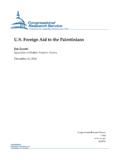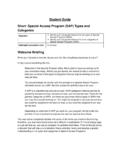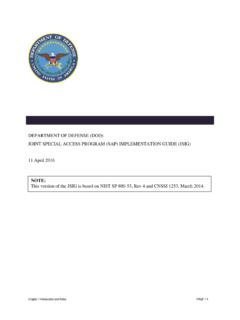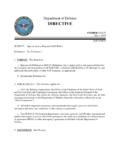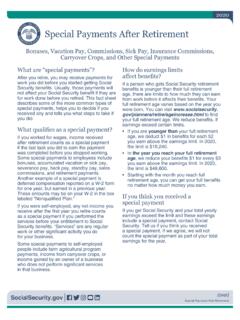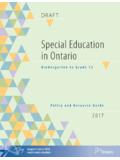Transcription of Budget 'Sequestration' and Selected Program …
1 CRS Report for CongressPrepared for Members and Committees of Congress Budget sequestration and Selected Program Exemptions and special Rules Karen Spar, Coordinator Specialist in Domestic Social Policy and Division Research Coordinator June 13, 2013 Congressional Research Service 7-5700 R42050 Budget sequestration and Selected Program Exemptions and special Rules Congressional Research Service Summary sequestration is a process of automatic, largely across-the-board spending reductions under which budgetary resources are permanently canceled to enforce certain Budget policy goals. It was first authorized by the Balanced Budget and Emergency Deficit Control Act of 1985 (BBEDCA, Title II of 99-177, commonly known as the Gramm-Rudman-Hollings Act). sequestration is of current interest because it has been triggered as an enforcement tool under the Budget Control Act of 2011 (BCA, 112-25).
2 sequestration can also occur under the Statutory Pay-As-You-Go Act of 2010 (Statutory PAYGO, Title I of 111-139). In either case, certain programs are exempt from sequestration , and special rules govern the effects of sequestration on others. Most of these provisions are found in Sections 255 and 256 of BBEDCA, as amended. Two provisions were included in the BCA that can result in automatic sequestration : Establishment of discretionary spending limits, or caps, for each of FY2012-FY2021. If Congress appropriates more than allowed under these limits in any given year, sequestration would cancel the excess amount. Failure of Congress to enact legislation developed by a Joint Select Committee on Deficit Reduction, by January 15, 2012, to reduce the deficit by at least $ trillion. The BCA provided that such failure would trigger a series of automatic spending reductions, including sequestration of mandatory spending in each of FY2013-FY2021, a one-year sequestration of discretionary spending for FY2013, and lower discretionary spending limits for each of FY2014-FY2021.
3 In fact, the Joint Committee did not develop the necessary legislation and Congress did not meet the January 15, 2012, deadline. Thus, automatic spending cuts under the BCA were triggered, with the first originally scheduled for January 2, 2013. 112-240 subsequently delayed this until March 1, 2013, and President Obama signed a sequestration order on that date. Under the Statutory PAYGO Act, sequestration is part of a Budget enforcement mechanism that is intended to prevent enactment of mandatory spending and revenue legislation that would increase the federal deficit. This act requires the Office of Management and Budget (OMB) to track costs and savings associated with enacted legislation and to determine at the end of each congressional session if net total costs exceed net total savings. If so, a sequestration will be triggered.
4 Under sequestration triggered either by the BCA or Statutory PAYGO Act the exemptions and special rules of Sections 255 and 256 of BBEDCA apply. Most exempt programs are mandatory, and include Social Security and Medicaid; refundable tax credits to individuals; and low-income programs such as the Children s Health Insurance Program , Supplemental Nutrition Assistance Program , Temporary Assistance for Needy Families, and Supplemental Security Income. Some discretionary programs also are exempt, notably all programs administered by the Department of Veterans Affairs. Also, subject to notification of Congress by the President, military personnel accounts may either be exempt or reduced by a lower percentage. special rules also apply to several, primarily mandatory, programs . For example, under Section 256 of BBEDCA, Medicare may not be sequestered by more than 4%.
5 However, under a BCA- triggered sequester, reduction of Medicare is limited to no more than 2%. Budget sequestration and Selected Program Exemptions and special Rules Congressional Research Service Contents Introduction .. 1 Current sequestration Triggers .. 1 sequestration Triggers Under the Budget Control Act (BCA) .. 2 Office of Management and Budget (OMB) Calculation of March 2013 sequestration .. 4 OMB Calculation of FY2014 sequestration .. 5 sequestration Trigger Under Statutory PAYGO .. 6 Program Exemptions and special Rules for sequestration .. 6 Section 255 Program Exemptions .. 7 Section 256 special Rules .. 10 Student Loans .. 10 Medicare .. 11 Health Centers, Indian Health, and Veterans Medical Care .. 15 Child Support Enforcement .. 17 Federal Pay .. 17 Federal Administrative Expenses .. 18 Unemployment Compensation.
6 19 Commodity Credit Corporation .. 19 Ta b l e s Table 1. OMB Calculations of FY2013 Uniform Percentage Reductions Under BCA-Triggered Sequester, Effective on March 1, 2013 .. 5 Appendixes Appendix. Section 255 of the Balanced Budget and Emergency Deficit Control Act, as Amended .. 21 Contacts Author Contact 28 Acknowledgments .. 28 Budget sequestration and Selected Program Exemptions and special Rules Congressional Research Service 1 Introduction sequestration is a process of automatic, largely across-the-board spending reductions to meet or enforce certain Budget policy It was first established by the Balanced Budget and Emergency Deficit Control Act of 1985 (BBEDCA, Title II of 99-177, 2 900-922) to enforce deficit targets. In the 1990s, sequestration was used to enforce statutory limits on discretionary spending and a pay-as-you-go (PAYGO) requirement on direct spending and revenue legislation.
7 After effectively expiring in 2002, sequestration was reestablished by the Statutory Pay-As-You-Go Act of 2010 ( 111-139) to enforce a modified PAYGO requirement on direct spending and revenue legislation. Most recently, under the Budget Control Act of 2011 (BCA, 112-25), sequestration was tied to enforcement of new statutory limits on discretionary spending and achievement of the Budget goal established for the Joint Select Committee on Deficit Reduction. A sequestration was triggered by the Joint Committee s failure to achieve its goal and was originally scheduled to occur on January 2, 2013, to affect spending for FY2013. Congress enacted legislation that delayed the effective date of this sequester until March 1, 2013 (American Taxpayer Relief Act of 2012, 112-240).2 In general, sequestration entails the permanent cancellation of budgetary resources by a uniform This uniform percentage reduction is applied to all programs , projects, and activities (PPAs) within a Budget However, the current sequestration procedures, as in previous iterations of such procedures, provide for exemptions and special rules.
8 That is, certain programs and activities are exempt from sequestration , and certain other programs are governed by special rules regarding the application of a sequester. This report provides an overview of those exemptions and special rules, which are generally found in Sections 255 and 256 of BBEDCA, as amended (2 905 and 906). While the report makes references to the sequestration currently in effect, triggered by failure of the Joint Committee process under the BCA, it discusses exemptions and special rules in general and should not be viewed as a comprehensive examination of the current or any future sequestration under either the BCA or the Statutory PAYGO Act. Current sequestration Triggers As noted above, sequestration is tied to certain Budget goals established in the Budget Control Act of 2011, as well as in the Statutory PAYGO Act of 2010.
9 To provide some context for the 1 For more information on sequestration and its historical application, see (1) CRS Report RL31137, sequestration Procedures Under the 1985 Balanced Budget Act, by Robert Keith; (2) CRS Report RS20398, Budget Sequesters: A Brief Review, by Robert Keith; and (3) CRS Report R41901, Statutory Budget Controls in Effect Between 1985 and 2002, by Megan S. Lynch. 2 President Obama issued the sequestration order on March 1, 2013. See 3 Budgetary resources include new Budget authority, unobligated balances, direct spending authority, and obligation limitations, as defined in Section 250(c)(6) of BBEDCA, as amended. 4 For accounts included in appropriations acts, programs , projects, and activities (PPAs) within each Budget account are delineated in those acts or accompanying reports; and for accounts not included in appropriations acts, they are delineated in the most recently submitted President s Budget .
10 See Section 256(k) of BBEDCA, as amended. Budget sequestration and Selected Program Exemptions and special Rules Congressional Research Service 2 exemptions and special rules applicable to these sequestration procedures, brief descriptions of the Budget goals that may be enforced by sequestration are provided below. Readers also may wish to consult the following CRS reports: CRS Report R41965, The Budget Control Act of 2011, by Bill Heniff Jr., Elizabeth Rybicki, and Shannon M. Mahan CRS Report R42949, The American Taxpayer Relief Act of 2012: Modifications to the Budget Enforcement Procedures in the Budget Control Act, by Bill Heniff Jr. CRS Report R42972, sequestration as a Budget Enforcement Process: Frequently Asked Questions, by Megan S. Lynch CRS Report R42675, The Budget Control Act of 2011: Budgetary Effects of Proposals to Replace the FY2013 Sequester, by Mindy R.









